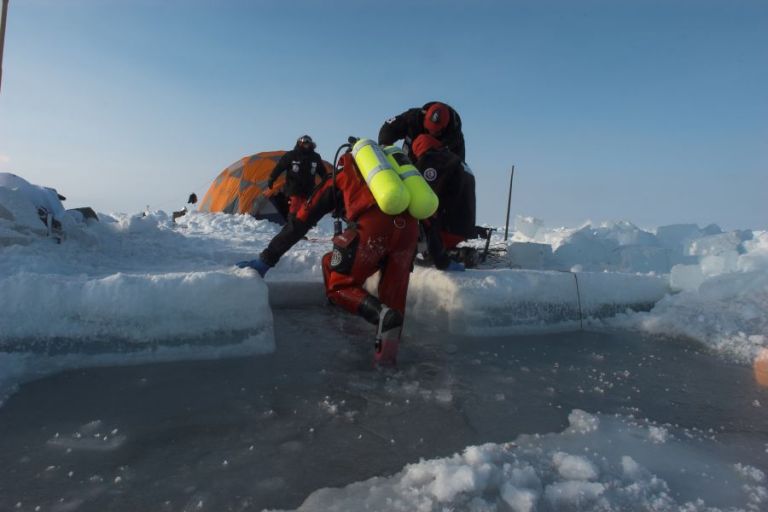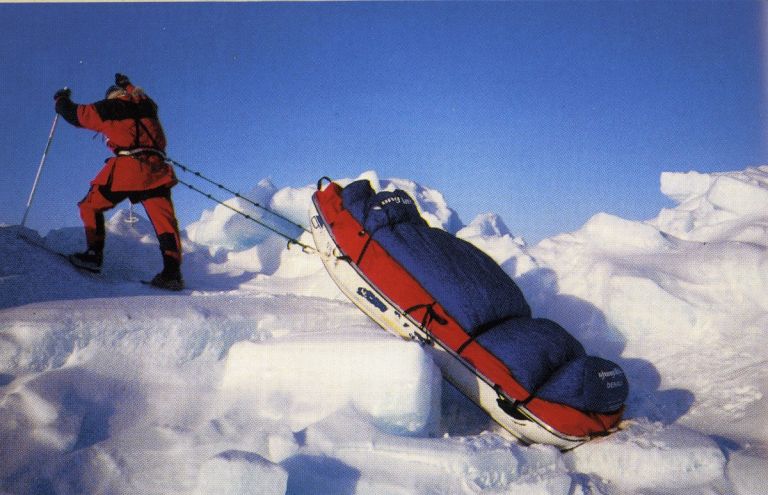Poland lies far from the Arctic and, when polar exploration was at its very peak, it didn’t even exist as a country. And yet, despite being scattered far and wide, many Polish researchers took active part in exploratory activity in polar regions. The most popular among them was Northeast Asia, or – more specifically – Siberia, Kamchatka and Novaya Zemlya. Only a few were active in Northern Canada and Greenland, and even fewer made it to the Antarctic. When Poland regained independence, many researchers returned to their homeland and successfully continued their polar studies.
The first idea for a scientific expedition to the North Pole was put forward in 1930 by the head of the National Institute of Hydrology and Meteorology (PIHM) Jean Lugeon, as a way to ensure Poland’s maximum participation in the 2nd International Polar Year. With an amphibious vehicle as their means of transport, the members of the expedition were to travel across the perennial ice cover of the Arctic Ocean (along a route following, most probably, the 17th meridian east), collecting data on the magnetic field and radio wave propagation. Study points were to be located at consecutive degrees of latitude and the team was to spend approximately one month at the North Pole. It was mainly for financial reasons that the idea came to nothing.
In 1936, Stefan Bernadzikiewicz, Konstanty Jodko-Narkiewicz and Stanisław Siedlecki completed a successful traverse of Spitsbergen from south to north. Their accomplishment might have become a catalyst for another push for the pole, but over the next few years the first two men focused their attention on high mountains (the Andes and the Himalayas) and the last one became totally engrossed in scientific studies.
The Second World War brought thriving Arctic research to a grinding halt and caused far-reaching political changes, which made it difficult for survivors to pick the work up where they left off. The first considerable post-war success came when Poland was included in the work of the International Geophysical Year 1957/58, which led to the construction of the Polish Polar Station in Hornsund, Spitsbergen. Poland had the right to carry out scientific exploration within the archipelago since 1931, when it became one of the signatories of the Spitsbergen Treaty, but a politically-motivated reluctance on the part of the Polish government made any actual activity in the area impossible. Participation in the International Geophysical Year was a breakthrough, which enabled a range of scientific units to resume and develop polar research.
By that time the Geographic North Pole had already been reached by a number of explorers (http://www.adventurestats.com/statistics.shtm#polar), so further attempts to reach it made sense only as a way to realise own or national ambitions.
The first idea of the sort emerged after balloon pilot Stefan Makne had won the Gordon Bennett Cup. According to the plan, in 1984 a team of three, comprising Makne himself, C. Filipowicz and W. Moskal (who was soon to become a household name in the polar world), were to fly a hot air balloon from Spitsbergen over the North Pole to Alaska, along the route taken originally by Amundsen’s Norge expedition. Unfortunately, the plan had to be cancelled for lack of sufficient funds.
In 1978, the Polish Polar Station Hornsund was renovated and turned into a year-round station, which excited growing interest in polar research. As a result, there appeared a new generation of polar enthusiasts, who were interested not only in scientific work but also in exploratory endeavours and sports activity in the polar regions. In the years 1979 and 1980, the above-mentioned Wojtek Moskal took part in students’ oceanographic expeditions to Spitsbergen organised by the University of Gdańsk. Soon afterwards, he made it to the Polish Polar Station Hornsund, where he overwintered as a member of a polar expedition of the Polish Academy of Sciences (1981/82). In the following years, he spent two more winters in Spitsbergen, this time on his own in old trapper cabins in Hornsund (1983/84) and at the northern tip of the island (1989/90).
With the exception of season 1987/88, when he overwintered in Antarctica as a member of a Greenpeace expedition (during which he made an unexpected visit to the South Pole), Wojtek Moskal spent his summers with consecutive oceanographic expeditions of the University of Gdańsk or working as a field assistant at the Norwegian Polar Institute. In 1990, during yet another stay in Spitsbergen, he met Marek Kamiński, an experienced young traveller who was at that time becoming active in the Arctic. The effects of this meeting weren’t long in coming. In 1993 the two men traversed the Greenland ice sheet, following Nansen’s route. In the winter of 1994, Wojtek Moskal and Wojtek Jazdon completed a ski crossing of the Gulf of Bothnia.
In 1995, Moskal and Kamiński set out for the North Pole, which had so far been reached by over 100 people. The unwritten rules were clear. If their accomplishment was to be treated seriously, they had to reach the pole unsupported. This is why they decided to do it on foot, manhauling all the necessary food and equipment. They set out on March 13 from Ward Hunt Island situated off the northern coast of Ellesmere Island in the Canadian Arctic and got to the North Pole on May 23 (from where they were picked up by a plane). By doing so they joined the ranks of the Conquerors of the North Pole (http://www.adventurestats.com/statistics.shtml#polar). Their names are numbers 121 and 122 in the general list, which starts with Cook, Peary and their companions, and numbers 12 and 13 in the list of those who made it to the pole on foot and without outside support.
In the year 2000 the pole became commercialised by Russians. Drawing on the experience of drifting research stations operating in the Arctic Ocean since 1937, they set up a temporary tourist base in the vicinity of the pole. The base, known as Camp Barneo, is open to tourists from March to May every year. Camp Barneo is equipped with helicopters (which can take tourists to the pole for a quick selfie), snowmobiles, and complete gear for everyone who might want to hike up to the pole over a distance of 100 to 150 km. The Camp can be reached by plane from Longyearbyen (Spitsbergen) or from Moscow via the Siberian town of Khatanga.
In the years 2001 and 2002, Moskal and Kamiński worked as polar guides for 10-person groups heading to the North Pole. The distance they covered each time was about 100 km. In 2001 their group included a woman, Katarzyna Kamińska, hailed as the first Polish woman at the North Pole.
Not long afterwards, in 2004, Moskal and Kamiński reached the pole again, this time as part of the initiative “Razem na biegun” (or “Together to the pole”). It was a brainchild of Marek Kamiński, who wanted to provide Jasiek Mela – a 15-year-old who had lost his forearm and a leg in an electric shock – with a powerful incentive to rehabilitate. The boy’s example was meant to convince other disabled children that it’s within their power to live active lives. Jasiek accepted the challenge and, after two years of arduous training, he left for the pole. The team which comprised Jasiek himself, Marek Kamiński, Wojtek Moskal and Wojtek Ostrowski (cameraman) set out from Camp Barneo and – after walking a distance of about 100 km – reached the North Pole. If this wasn’t good enough, the challenge helped to raise money that paid for 65 high-quality prosthetic limbs for disabled children and inspired Jasiek Mela to set up a foundation which to this day provides support to amputees and their families.
In 2006, Camp Barneo featured in one more spectacular initiative, namely “Nurkowanie na biegunie” (or “Diving at the pole”). It was from the Camp that a team of divers, with Leszek Czarnecki as leader and Wojtek Moskal as polar guide, travelled by helicopter to the pole, where they put up their tents and spent two days diving under the ice. Once they had finished, they took a helicopter back to Camp Barneo and a plane to Spitsbergen. The undertaking was widely publicised as the first ever under-ice diving at the North Pole.
Two years later, in 2008, the pole was reached by an international team of five, one of whom was Piotr Szczepanik. The team travelled on skis, but there is no information available as to where they had started. The expedition was accompanied by fund raising to support the Tatra Volunteer Search and Rescue team (TOPR).
Logistical benefits provided by Camp Barneo were not lost on Richard Donovan, who organises extreme long-distance running events. As a result, since 2003 the North Pole has been the setting of the North Pole Marathon, held over a classic distance of 42 km. The first edition of the event was attended by only three runners – the organiser himself and two of his friends. With time, however, the race attracted more running enthusiasts. Nowadays, their number varies between 30 and 40, depending on the year. Polish runners have taken part in it since 2008 and they have even climbed the podium! In 2017, the winner of the North Pole Marathon was Piotr Suchenia.
Another polar challenge worth mentioning had little to do with the geographic pole. It involved the Pole of Cold, or the area surrounding the Russian village of Oymyakon, located in Krasnoyark Krai in Siberia. The lowest temperature recorded there was -78°C! The aim of the challenge was to test human resistance to extremely low temperatures. Devised by Walerian Romanowski and Piotr Marczewski, it involved covering 2000 km on a bicycle (by the former) and 400 km on foot (by the latter). The greatest difficulty, however, was not the distance, but the assumption that – with air temperature as low as -50°C – the men were not to make use of any sources of heat. This meant, among others, that they could only use their own body heat to melt ice for drinking water and that they could not heat up their food. The men followed the rules, but had to limit the distance to 400 km for Romanowski and 180 km for Marczewski. To make sure that nobody got hurt during the experiment, a support team consisting of paramedics followed the participants at a distance of about 2–3 hours’ drive.
Author: Jerzy Giżejewski, PhD








